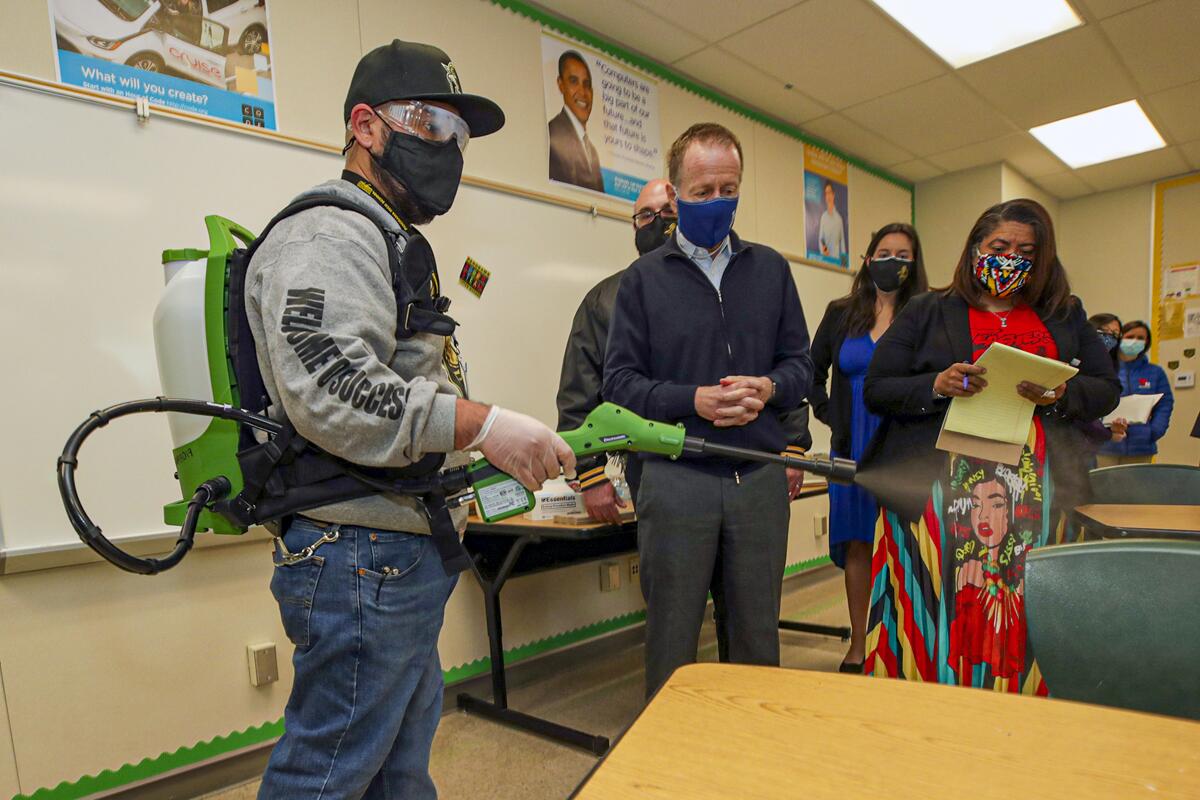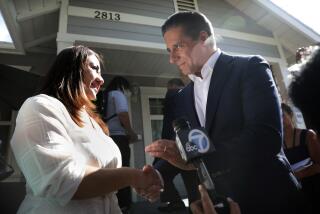Many LAUSD parents don’t plan to send kids back to campus, early survey results find

- Share via
About half of Los Angeles Unified students will not be returning to campus, based on early, partial results of a parent survey, with more wariness expressed in communities hit hard by COVID-19 and among families with older students whose return options include no escape from online learning.
The parent survey, begun last week, is far from complete but provides an early look at preferences among the families of 465,000 kindergarten through 12th-grade studnets in the nation’s second-largest school system. So far, about 10% of parents have submitted the surveys, which ask families to select between remaining in full remote learning or returning to campus for about half the time starting in about mid-April or later.
Overall, 51% of those responding chose the in-person hybrid option. Among grade levels, 62% favored a return at the elementary level, 44% at middle school and 33% at high school.
The district on Monday also released a snapshot by community, indicating that harder-hit areas were more reluctant to send children back.
“The trauma, anxiety and very real concern about the virus isn’t going away just because a few politicians declare it’s time to reopen,” said L.A. schools Supt. Austin Beutner in his weekly broadcast Monday, without naming the officials to whom he was referring. “It will take time to heal and for the communities we serve to trust government to protect them after the tragedies over the last many months.”
Restaurants, movie theaters, gyms reopen in L.A. County today
This difference by community shows up primarily at the elementary school level in areas highlighted by the district. For instance, in Florence-Firestone/Watts, 43% of students would be returning. That area has a COVID-19 death rate of 279 residents per 100,000, according to data released by the district, and a vaccination rate of only 7%.
By contrast, in West L.A., with a much lower death rate and much higher vaccination rate, 77% of students would go back, including 88% of elementary students.
“While it’s still early and the numbers will change, we see the greatest reluctance to sending their children back to schools in the communities hardest hit by the virus,” Beutner said. “These also happen to be the same communities where families are struggling to get by and most likely to have had someone in the family who lost work due to the virus.”
Several factors could account for the differences at the various age levels. For one, distance learning is generally more difficult for younger children, and the need to provide child care to allow parents to return to work is especially acute.
In addition, the program being offered is more like normal school for the younger students — who would return to campus Monday through Friday for a three-hour session. Elementary school students also would have access to supervision outside of those three hours, covering the period from 8 a.m. to 4 p.m.
For middle school, the supervision remains available from 8 a.m. to 4 p.m., but students will either have limited or no in-person interaction with a teacher for academic instruction.
High school students can return to campus in a schedule that alternates weeks with two and three days on campuses, but it won’t resemble traditional instruction.
At the secondary level, students will spend the class day in one classroom supervised by one teacher, who likely will not be teaching them. In that setting, each student will log on for the same online learning classes they would otherwise be carrying out at home, including physical education. The instructor, meanwhile, would be teaching online, but not necessarily to any of the students in the room.
The union and district agreed to the secondary school format as a way to keep students in small stable groups. The goal was to limit potential spread of the virus and also to avoid changing master schedules, which are complex at the middle and high school levels.
Families can change their minds about returning to campus at two-week intervals, and Beutner acknowledged a need to “build the trust of all stakeholders in the school community.”
He connected this wariness to a lack of “clear and consistent standards about what constitutes a safe school environment,” adding that “health authorities still need to align local, state and federal guidelines.”
Health guidelines have evolved repeatedly over the course of the pandemic, in large measure because knowledge about COVID-19 has evolved, although political considerations — and disagreements — also have affected public policy. Nonetheless, current guidelines from county, state and federal health agencies are less stringent about safeguards than those settled on by L.A. Unified.
Under county health guidelines, for example, secondary schools can permit students to move from class to class, with the county recommending that groups of students potentially interacting to not exceed 100. All campuses for all students became eligible to reopen as of Monday.
By any measure there’s much to clarify. At last week’s school board meeting, officials said the default for elementary school would be an in-person session in the morning and a virtual session in the afternoon — because teachers would not be expected to manage students in person and online at the same time. But a reopening guide for parents suggested that in-person morning and afternoon sessions are equally available. In Beutner’s Monday remarks he included a Q-and-A with senior administrators suggesting that parent preferences would guide planning from campus to campus.
The surveys, which are due by Friday, are expected to provide L.A. Unified with the information it needs for managing close to 1,400 schools at nearly 1,000 campuses. School leaders will also be holding a series of online meetings with parents beginning this week to discuss reopening plans.
The teachers union and district continue to negotiate over conditions related to classes for students with disabilities.
Some services for these students resumed on March 4, including services for students learning English. The district declined to release information about how many students are being reached. In the fall, such services reached fewer than 1% of students before being suspended during the winter surge of the pandemic.
More to Read
Sign up for Essential California
The most important California stories and recommendations in your inbox every morning.
You may occasionally receive promotional content from the Los Angeles Times.












